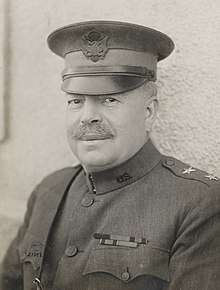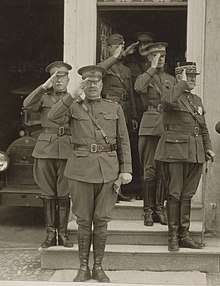Joseph T. Dickman
Joseph Theodore Dickman (October 6, 1857 – October 23, 1927) was a United States Army officer who saw service in five wars, rising to the rank of major general.
Joseph T. Dickman | |
|---|---|
 Major General Joseph T. Dickman in October 1918 | |
| Born | October 6, 1857 Dayton, Ohio, U.S. |
| Died | October 23, 1927 (aged 70) Washington, D.C., U.S. |
| Buried | |
| Allegiance | United States |
| Service/ | United States Army |
| Years of service | 1883–1922 |
| Rank | Major General |
| Commands held | Third Army I Corps IV Corps 3rd Infantry Division 85th Division 2d Cavalry Regiment |
| Battles/wars | Apache Wars
|
| Awards | Army Distinguished Service Medal Commander of the Legion of Honour (France) Croix de Guerre (France) Grand Officer of the Order of Leopold (Belgium) Grand Officer of the Order of the Crown of Italy Knight Commander of the Order of the Bath (United Kingdom) Medal of Solidarity (Panama) |
| Other work | Memoirs (1927) Translated General Von der Goltz's, "Conduct of War" |
Early life
Dickman was born in Dayton, Ohio. He attended the University of Dayton and graduated in the class of 1871. In 1881 he graduated from the United States Military Academy at West Point and was commissioned in the 3rd Cavalry.[1]
Military career
Apache Wars and Border Duty 1883–1898
Dickman graduated from the United States Army Cavalry School in 1883 and proceeded directly to the Indian territory, where he participated in the Apache War from 1885–1886, to include the Geronimo Campaign. He next participated in the Mexican border patrol operations during the Garza Revolution against Garza revolutionists and the bandits, Benavides and Gonzales.[1]
Dickman's early experience sent him to Fort Riley, where he was an Instructor at the Cavalry and Light Artillery School from 1893–1894. He deployed to the Pullman Strike in Chicago 1894. Later that year, he was assigned to Fort Ethan Allen, Vermont.
Spanish–American War, 1898–1900
Dickman's deployment during the Spanish–American War was notable. He participated in the Battle of San Juan Hill-El Caney, Santiago de Cuba. He served on the staff of General Joseph Wheeler during the Philippine–American War from 1899–1902 and at the Battles on the Island of Panay from 1899–1900.[1]
Boxer Rebellion, 1900
During the Boxer Rebellion, Dickman was Chief of Staff to General Adna R. Chaffee for the Peking Relief Expedition and fought in the battle at Pa-ta-Chao, Peking on September 26, 1900.[1]
1902–1917
Dickman was on the Army General Staff from 1902–1905. He was an instructor at the Army War College from 1905–1912. Dickman was the US Army Inspector General from 1912–1915, taking over 2nd US Cavalry in 1915. He was given command of the 85th Infantry Division, Camp Custer, Michigan, in August 1917.
World War I, 1917–1918

Dickman was given command of the 3rd Infantry Division in November 1917, at the onset of the United States' entrance into World War I. He deployed the 3rd Division to France aboard the Leviathan at noon, on March 4, 1918. He was the 3rd Division commander at Chateau-Thierry in May 1918 and was made famous at the Second Battle of the Marne in July 1918. While allied forces on both flanks retreated, the 3rd Division stood fast in the face of enemy offensives, which led to their moniker, "The Rock of the Marne."
Dickman commanded IV Corps from August to September 1918, to include the Saint-Mihiel Offensive in September 1918. He then commanded I Corps from October to November 1918, to include the Meuse-Argonne Offensive.
The Third Army was established under the command of Dickman by General John J. Pershing in France to advance to the Rhein and hold the Coblenz bridgehead, then prepare to serve after the war as the Army of Occupation of the Rhineland. The Third Army would have become the Army of Occupation whether or not the enemy signed the peace agreement. American fighting units not sent home were consolidated under Third Army and prepared to attack if Germany did not accept the terms of peace. The United States itself was not to sign the agreement but remained technically at war with Germany for two more years.[1]
Post war
Dickman returned from World War I to serve as President of the Tactics and Organization Board, which reported on lessons learned during the war from April–July 1919. Dickman served as Commanding General of the VIII Corps Area from 1919–21. He retired on October 6, 1921. He was later recalled to preside over postwar-army downsizing board in 1922. His memoirs were published in 1927.
Dickman died in Washington, D.C., on October 23, 1927.[1]
Dates of Rank
| Second Lieut., 3d Cavalry, June 11, 1881 |
| First Lieut., 3d Cavalry, Jan. 18, 1886 |
| Captain of Cavalry, 8th Cavalry, May 27, 1898 |
| Major, 26th U. S. Volunteer Infantry, July 5, 1899 |
| Lieut.‑Colonel, 26th U. S. Volunteer Infantry, Sept. 13, 1899 |
| Major 13th Cavalry, March 7, 1906 |
| Lieut.‑Colonel of Cavalry, Feb. 29, 1912 |
| Colonel of Cavalry, Dec. 14, 1914 |
| Brigadier-General, U. S. A., May 15, 1917 |
| Major-General, National Army, Aug. 5, 1917 |
| Major-General, Jan. 9, 1919 |
| Vacated Commission as Major-General, National Army, Only, Jan. 7, 1920 |
| Major-General, U. S. A., Retired, Oct. 6, 1921, By Operation of Law. |
Awards and decorations
- American awards
| Army Distinguished Service Medal | |
| Indian Campaign Medal (Geronimo Campaign), 1885 | |
| Spanish Campaign Medal, 1898 | |
| Army of Cuban Occupation Medal, 1899 | |
| Philippine Campaign Medal, 1899 | |
| China Campaign Medal, 1900 | |
| Mexican Border Service Medal, 1916 | |
| World War I Victory Medal (United States), 1919 (with six clasps) |
- Foreign awards
| Croix de Guerre with palm (France), 1918 | |
| Grand Officer of the Order of Leopold I (Belgium), 1919 | |
| Knight Commander of the Order of the Bath (Britain), 1919 | |
| Commander of the Order of the Legion of Honour (France), 1919 | |
| Grand Officer of the Order of the Crown (Italy), 1919 | |
| Medal of Solidarity (Panama) |
| The honorary degree of LL.D. was conferred on him by the University of Vermont. |
Historical footnotes
USS Joseph T. Dickman
The USS Joseph T. Dickman (APA-13) and the USS Hunter Liggett (APA-14), along with the USS Leonard Wood (APA-12), were the largest attack transports in the Amphibian Force during World War II. They each carried 35 landing boats and 2 tank lighters, along with 51 officers and a crew of 634. These newly commissioned U.S. Navy vessels were operated by the US Coast Guard. The USS Joseph T. Dickman carried soldiers of the 4th Infantry to the beaches of Normandy during Operation Overlord on D-Day.
The Dickman Rifles
The famous National Society of Pershing Rifles had its origin in 1894, when future General John J. "Black Jack" Pershing, then a Second Lieutenant in charge of military instruction at the University of Nebraska, started a "Varsity Rifles" drill team. A year later the unit was recognized as a fraternity and took on the formal name of "Pershing Rifles."
Similarly, the Dickman Rifles was an honorary military society formed at the University of Dayton to honor Maj. Gen. Joseph T. Dickman, Class of 1871. In May 1931 the Dickman Rifles were invited to a Pershing Rifles drill competition. This exposure to the National Society of Pershing Rifles led to a petition from the members to join the National Society.
Published works
- Dickman, Joseph Theodore. The Great Crusade. A Narrative of the World War. NY: Appleton, 1927. An account of his war experiences.
- Lieutenant, 3rd Cavalry. "Balloons in War." Cavalry Journal. 10: June 1897, 103–12.
- Major, Inspector General. "Cavalry Organization." Cavalry Journal. 22: January 1912, 650–56.
- Lieutenant, 3rd Cavalry. "Dickman Field Holder (R)" Cavalry Journal. 10: March 1897, 80–82.
- Captain, 8th U.S. Cavalry. "Experiences in China." Cavalry Journal. 13: July 1902, 5–40.
- Lieutenant, 3rd Cavalry. "Field Exercise at Fort Leavenworth." Cavalry Journal. 10: June 1897, 158–66.
- Captain, 8th Cavalry. "General Service and Staff College, Fort Leavenworth." Cavalry Journal. 13: October 1902, 217–31.
- Major General, USA (Ret). "Great Crusade (R)." Cavalry Journal. 36: April 1927, 328.
- "Has the Buffalo a Sense of Humor?" Cavalry Journal. 35: April 1926, 216.
- Major. "Marching Cavalry in Rolling Country." Cavalry Journal. 18: April 1908, 703–08.
- Lieutenant, 3rd Cavalry. "Military Policy and Institutions." Cavalry Journal. 10: December 1897, 383–96.
- First Lieutenant, 3rd Cavalry. "New Method of Loading the Revolver." Cavalry Journal. 7: June 1894, 178–79.
- "Outline Descriptions of the Horse." Cavalry Journal. 10: March 1897, 40–44.
- "Patrol Duty." Cavalry Journal. 11: March 1898, 102–44.
- Maj. Gen., CG Third Army, A.E.F. "Plea for the Saber." Cavalry Journal. 29: October 1920, 251–53.
- "Word to the Cavalry (by Captain Ludwig Drees)." Cavalry Journal. 29: April 1920, 93–96.
- Dickman, Joseph T. (intro.) History of the Third Division United States Army in the World War. Andernach-On-The-Rhine, 1919. 397 p.
- Dickman, J.T. et al. The Santiago Campaign. Richmond, VA: Williams, 1927. 442 p.
- Dupuy, Trevor N., et al. The Harper Encyclopedia of Military Biography. NY: Harper Collins Publishers, Inc., 1992. p. 219.
- General Orders No. 17, War Department, 1927. Summarizes his career.
- Pitt, Barrie. 1918: The Last Act. New York, 1963.
Translations
- General Von der Goltz's, "Conduct of War."
References
- Association of Graduates, U.S.M.A. Register of Graduates and Former Cadets. Cullum no. 2905.
- Third US Army Official Dickman Bio
Notes
- Davis, Jr., Henry Blaine (1998). Generals in Khaki. Raleigh, NC: Pentland Press, Inc. p. 107. ISBN 1571970886.
- "Joseph T. Dickman • Cullum's Register • 2905".
- "Joseph T. Dickman • Cullum's Register • 2905".
External links
| Wikimedia Commons has media related to Joseph T. Dickman. |
| Military offices | ||
|---|---|---|
| New command | Commander 3d Infantry Division 1917–1918 |
Succeeded by James Anderson Irons |
| Preceded by Hunter Liggett |
Commander I Corps October – November 1918 |
Succeeded by Hunter Liggett |
| New command | Commander Third Army 1918–1919 | |